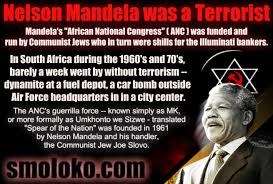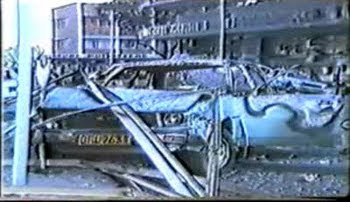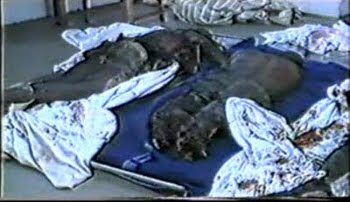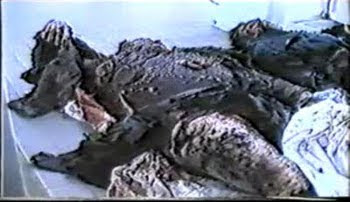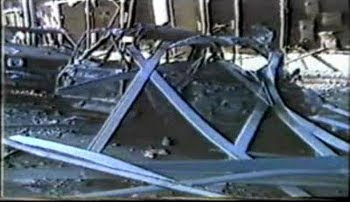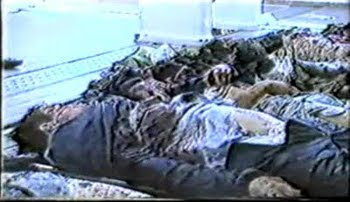Guerrilla warfare, as fought by the Boers one century ago, is recognized internationally as the honourable defence by disciplined fighters against a superior, armed enemy. The Boers attacked classical military targets, even though outnumbered most of the time by overwhelming numbers. The so-called ‘freedom fighters’ of Southern Africa, however, be they Frelimo, Zanu, Swapo or the ANC/Communist Mkonto e Sizwe (MK), very seldom attacked anything resembling a military target, – on the contrary, they specialized in the callous bombing of Wimpy Bars, the cowardly laying of landmines on farm roads, the barbarian ‘necklacing’ of defenceless township dwellers, and even the brutal torture of their own dissident comrades. What makes these atrocities more despicable is that some of the organizations actually signed the Geneva Protocols, which explicitly forbid this kind of terror and cruel intimidation. Serious students who wish to get an unbiased and balanced picture of the kind of terrorist ‘war’ fought by terrorist organisations like the ANC/SACP, the PAC and others should read the book The Other Side of the Story by Herman Stadtler, Sigma Press, ISBN 0-620-21100-8.
The Church Street bombing was a car bomb attack on 20 May 1983 by Umkhonto we Sizwe, the military wing of the African National Congress, in the South African capital Pretoria. The bombing killed 19 and wounded more than 200, and was one of the largest attacks engaged in by the ANC during its armed struggle against apartheid. The attack consisted of a car bomb set off outside the Nedbank Square building on Church Street at 4:30pm on a Friday. The target was South African Air Force (SAAF) headquarters, but as the bomb was set to go off at the height of rush hour, those killed and wounded included civilians. The bomb went off ten minutes earlier than planned, killing two ANC operatives in the vehicle, Freddie Shangwe and Ezekial Maseko. At least 20 ambulances took the dead and wounded to hospital.
1983: Car bomb in South Africa kills 16
BBC: On This Day
20 May 1983
At least 16 people have been killed and more than 130 people injured in a car bomb explosion in South Africa’s capital city, Pretoria.
The explosion happened outside the Nedbank Square building on Church Street at about 1630 hours – the height of the city’s rush hour.
More than 20 ambulances attended the scene and took the dead and injured to three hospitals in and around Pretoria.
Police sealed off the surrounding area with a barbed-wire fence as emergency personnel sifted through the rubble looking for bodies.
Bomb disposal experts were called to the scene to search for a possible second bomb.
The outlawed anti-apartheid group the African National Congress has been blamed for the attack.
Bled to death

A huge pall of smoke rose hundreds of feet into the air as debris and bodies were strewn around the scene of the explosion.
It is understood the bomb had been placed in a blue Alfa Romeo car outside the multi-storey building, which houses the South African air force headquarters.
It exploded at the height of the city’s rush-hour as hundreds of people were leaving work for the weekend.
Glass and metal were catapulted into the air as shop-fronts and windows were blown out.
Many passers-by had limbs amputated by the flying debris. Others bled to death.
South Africa’s Minister for Law and Order, Louis le Grange, who visited the scene immediately, blamed the attack on the ANC.
He said: “I have no doubt who is responsible for this despicable attack.”
He said the explosion was the “biggest and ugliest” terrorist incident since anti-government violence began in South Africa 20 years ago.
He added: “Most of the victims were civilians, but some were air force personnel in uniform, black and white. Quite a number of those killed were black.
The ANC is committed to overthrowing the minority white government.

Oliver Tambo, who is the organisation’s acting president while its senior figure, Nelson Mandela, is in prison, said the Nedbank Square building was a legitimate target, although he did not admit carrying out the attack.
General Mike Gedenhuys, Police Commissioner, said: “Many of the victims are so badly mutilated they have not yet been identified.”
General Magnus Malan, South African’s defence minister, described the explosion as a “cowardly, criminal deed in the Communist war being raged against South Africa”.
He said more than 40,000 civilians had died as a result of terrorism in the past five years in Africa and 83,000 armed men had died.
South Africa has nearly five million whites, 21 million blacks, nearly one million Indians and about 2.5 million people of mixed race.
The government’s apartheid system denies citizenship rights to black people except in 10 remote homelands.
The ANC has warned it intends to step up its campaign to bring an end to white minority rule.
» » » » [BBC] [Bomb Photos: Kerkstraatbom]

Background Information: Church Street Bomb – 20th of May 1983
May 20, 2008
by Kobus, Afriforum
The Police investigation of the bomb explosion in Church Street West, PRETORIA, on the 20th of May 1983 at 16:28, brought the following facts to light:
[1] The bodywork of the vehicle in which the bomb had exploded, had totally disintegrated. The engine number had been scoured off. By means of the chassis number found amongst the rubble, the vehicle could be identified as a cream-coloured 1982 model Colt Galant. It had been stolen on the 19th of June 1982 from the premises of Mr V.A. Sabattier at number 5, Sixth Avenue, Edenvale. Amongst the rubble a piece of the vehicle’s number plate was also discovered. The registration number started with “SD”.
[2] As a result of the explosion, 19 people died – 17 men (8 black, 9 white) and 2 women.
[3] Considerable damage occurred to buildings and vehicles in Church Street West between Bosman and Schubart Streets. The damage amounted to approximately R4 000 000 in the terms of 1983.
[4] Evidence was obtained that a cream-coloured Colt Galant with a “SD” registration number had been brought to the home of Bakayi Ezekiel Maseko at Block J 2824, Mamelodi on 20 May 1983 at about 11:00 by a certain Freddi Butana Shongwe of Block B388, Mamelodi. Shongwe asked a certain Jerry Shabangu whether the origin of a vehicle could still be ascertained after the engine number had been removed. He showed the cream-coloured Colt Galant to Shabangu where it had been hidden behind Maseko’s home. Shongwe mentioned to Shabangu that the vehicle would be used for a “great undertaking”, without saying what this “undertaking” would entail. Maseko’s wife, Anna, saw Maseko and Shongwe removing the engine number with an electrical sander.
[5] At about 15:50, Shongwe hurriedly left in the Colt Galant, with Maseko following him with the latter’s Kombi. They were in such a rush that they left the electrical sander outside the home where they had been working with it.
[6] From the 20th of May 1983, Shongwe and Maseko did not return home, and their families started looking for them.
[7] On the 28th of May 1983, Maseko’s Kombi was found behind the Poyntons Building in Schubart Street, Pretoria. The vehicle was not locked. Inside the vehicle, a jacket of Shongwe which he had been wearing on the 20th of May 1983 was found, as well as a paper bag, containing a portable radio. After the vehicle and its contents had been removed, the families started suspecting that Maseko and Shongwe might have been amongst the victims of the explosion. Maseko’s body was subsequently identified at the Government Morgue. His body had been found on the northern side of Church Street, right opposite the place where the bomb had exploded.
[8] After the explosion on the 20th of May 1983, several body parts were found scattered all over the scene of the explosion. On the 13th of June 1983 the feet of this person was identified by his mother as being those of Freddie Shongwe. Shongwe’s wife also identified a piece of trousers and a belt found at the scene, as items belonging to Shongwe. From the dispersal and parts found on the wreckage, it could be deduced that Shongwe had been inside the vehicle at the time of the explosion.
[9] According to evidence given by a witness who had been sitting in her car in front of the Nedpark Building in Church Street West, Pretoria, on the 20th of May 1983, a cream-coloured Colt Galant had parked in front of her. Immediately after the vehicle had come to a standstill, the explosion followed.
[10] On the 7th of July 1983, Anna Maseko handed the electrical sander, as well as the portable radio, to the investigators. Upon examination it was found that the portable radio discovered in Maseko’s Kombi, had been fitted with a remote control. Experts found this remote control to be fully functional. It was also able to detonate explosives from a distance. According to the experts, the frequency at which the remote control had been set, is extremely sensitive and could have been activated by other factors coming within the range of the control unit.
[11] In Maseko’s clothes in his home, cash to the value of R3 000 was found. Anna Maseko could not find any explanation for the origin of this money. She had used some of the money for funeral costs.
[12] Shongwe and Maseko had previous convictions for “housebreaking and safe robberies”.
[13] On several occasions, Shongwe and Maseko accompanied each other to Swaziland. Shongwe sometimes visited Swaziland as often as twice per month. Evidence was found that Shongwe had been seen at the homes of well-known members of the African National Congress (ANC) in Swaziland. Shongwe is a cousin of a trained ANC member, Johannes Mnisi. According to information received, Shongwe and Maseko had had contact with Mnisi in Swaziland. It was also established that Shongwe had last visited Swaziland from 16 to 17 May 1983.
During the activities of the Truth and Reconciliation Commission (TRC), amnesty for the Church Street Bomb was granted to Aboobaker Ismail, former head of Umkhonto we Sizwe’s unit for special operations, and Johannes Mnisi. In spite of the fact that the ANC in the past had already acknowledged that the actions of its military wing, Umkhonto we Sizwe (MK), “at all times had been subject to the political leadership of the ANC”, no member of the ANC’s NEC of that time ever applied for amnesty for the Church Street Bomb.
» » » » [Afriforum] [Bomb Photos: Kerkstraatbom]

Tambo Ordered Church Street Blast: ANC
May 12 1997
SA Press Assoc. Sapa
Former African National Congress president Oliver Tambo ordered the 1983 bombing of the SA Air Force Headquarters in Church Street, Pretoria, to avenge a cross-border raid into Lesotho by South African security forces.
Tambo is identified as the person who gave final approval for the operation, in the ANC’s second submission to the Truth and Reconciliation Commission on Monday.
It said Tambo asked the ANC’s national executive committee for a mandate in 1979 to form a special unit to attack key strategic targets – “spectacular operations that would hit the economy hard, and inspire the oppressed majority”.
The first special operations command consisted of former Housing Minister Joe Slovo, Montso Mokgabudi and Aboobaker Ismail, who has also been linked to the June 1986 Magoos bar bomb-blast.
The submission said the Church Street bomb-blast followed a cross-border raid into Lesotho in which 42 ANC supporters and Basotho were killed, and the assassination of Slovo’s wife, Ruth First, in Maputo, Angola.
“With the increasingly indiscriminate attacks on neighbouring states and the viciousness of attacks on SA civilians by the security forces, it was decided by special operations command to attack military personnel.
“This resulted in operations such as the car bomb at South African Air Force HQ in Pretoria.”
At the time of the bombing in 1983 special operations command no longer reported directly to Tambo.
Ismail had been appointed overalL commander of the unit and reported directly to Slovo, then chief of staff, at military headquarters.
“The objective was to carry out a highly visible attack which was impossible to cover up, against military personnel in uniform,” the submission said.
It was decided, therefore, to target military personnel who waited for buses outside SAAF HQ at 4.30pm each day.
In the early stages of planning the operation discussions had been held on the possible loss of civilian life, and whether this would be justified.
“After careful consideration it was decided by OR (Oliver) Tambo, in terms of the mandate he had given by the NEC, that special operations should proceed with the operation, taking great care that the target was unmistakably military.
On the afternoon of May 20 1983, the unit had driven into Pretoria and parked the car packed with explosives in Church Street, at the entrance to air force headquarters.
When the bomb exploded a few minutes earlier than planned, 19 people were killed, including both Umkhonto we Sizwe cadres and 11 air force personnel.
“According to initial media reports, more than 200 military personnel and few civilians were injured, but these figures were later distorted by the government in an attempt to portray this attack as aimed at civilians.”
The attack on the headquarters had not contradicted ANC policy to avoid civilian casualties.
Instead, it illustrated the problems which had arisen as a result of strategic installations being placed in high-density civilian areas, the submission said.
» » » » [Dept. of Justice/TRC] [Bomb Photos: Kerkstraatbom]

Mandela & the Church Street Bombing
Springbok Club
Patriot Forum
Here are photos showing the Church Street bombing. As mentioned before, in his so-called book, “Long Walk to Freedom“, Mandela says that he “signed off” with this act of terrorism. People should take a look at what Mandela “signed off” with while he was in prison – convicted for other acts of terrorism!
President P.W. Botha told Mandela way back in 1985, that he could be a free man as long as he did one thing: Publicly renounce violence. Mandela refused. That is why Mandela remained in prison until the appeaser F.W. de Klerk freed him unconditionally. The bottom line is that Nelson Mandela never publicly renounced violence – and we should never forget that.
Poster distributed by the Federation of Conservative Students (the official Conservative Party student organisation) in Britain during the early 1980’s, clearly illustrating that people overseas were more aware of the evil nature of Mandela and his fellow ANC terrorists than most people in South Africa were.
************************South Africa’s “Truth and Reconciliation Commission” – ostensibly set up to cleanse that nation’s psyche of its tortured past – is finding that the Marxist revolution fought there between 1948 and 1994 witnessed a departure from the normal rules of war by both the communist African National Congress and the Christian, pro-West NP government.
The TRC’s official goal is to investigate crimes committed by both the Marxist ANC and the right-wing government during the apartheid era. Crimes committed by other groups, including the Inkatha Freedom Party, are also being investigated. If those charged with crimes promise to tell all they know to the commission, they can be granted amnesty. Under ongoing hearings before the Truth and Reconciliation Commission, the sordid and often macabre blood sport that characterized this war has been leaking out in dribs and drabs to a global audience. Most of those appearing before the TRC can apply for amnesty and escape prosecution if they admit their guilt. Many have chosen this route and testified against either the Afrikaner leadership or the ANC. Others, like Winnie Mandela (ex-wife of Nelson Mandela) and former South African President P.W. Botha, have maintained their innocence to the very end. The ANC at first denounced a parliamentary bill granting amnesty for those who request it from the Truth and Reconciliation Commission. The feeling among the ANC was that it would provide a blanket amnesty for the torture and killings conducted by the right. However, as more and more of the ANC’s misdeeds are exposed, some have concluded that the Marxist organization is also in need of blanket amnesty.
The misdeeds of the Soviet-sponsored ANC have been well chronicled. It operated under and parallel to the South African Communist Party, established in the early 1920s as the first Communist Party outside the Soviet Union. In fact, the party was set up under the slogan “Workers of the world unite and fight for a White South Africa”. Throughout the Cold War, the Soviets provided training and advisors to the ANC. The Soviet Union sent troops and billions of dollars in arms to fight a war in Angola. This was a part of the Brezhnev Doctrine to “seize the strategic mineral treasure chest of Southern Africa and deny these materials to the Western military-industrial complex.” These minerals included titanium, used to build fighter jets, and zirconium oxide, a rare commodity used to sheathe nuclear reactor fuel.
The crimes committed by the ANC in the name of liberation are legion. First, there was the practice of “necklacing,” in which a petrol-filled tyre is placed around the neck of a victim and set ablaze – an action carried out by Winnie Mandela and her minions. Another horror was the “Church Street Massacre,” in which Nelson Mandela approved of a bomb set to explode at rush hour to maximize casualties of Afrikaner women, children and babies. The same Mandela who told the Black youth of South Africa to “burn down” their schools has produced a lawless, unemployable generation. Mandela recently travelled to Libya and presented Gaddafi with South Africa’s highest military medal.
Through the work of the Truth and Reconciliation Commission, the gulags of northern Angola – where the ANC mutilated and tortured cadres who would not go along with the terrorist campaign – have also been brought to light. The ANC has admitted that torture and “staggering brutality” were committed at their Angolan re-education camps in the 1980s and “could have caused prisoner deaths.” In an internal report, the ANC documented 17 eyewitness accounts of detainees who survived the camps. “The ANC routinely violated its own code of conduct with physical and psychological torture,” said the report. One detainee has written a book about the camps, which he referred to as “a scene from [the film] ‘Spartacus.'” The report – which was authored by two ANC officials and an independent advocate – did not single out any ANC members responsible directly for torture, although it is believed the late ANC activist Chris Hani was involved. Nelson Mandela has refused to apologize for what he said were “inexcusable” violations of human rights during the ANC’s terror campaign against the White-led government. Mandela did, however, admit that torture occurred at ANC prisons and camps, but the report now documents that this
abuse was widespread and far-reaching. Torture and murder occurred not only in Angola, but also in ANC re-education camps in Uganda and Tanzania.
This report was a major embarrassment to the ANC, which had been lionized in the West for its war to end apartheid and install a supposedly democratic government in South Africa. Detainees recounted in the report that they were tortured for disagreeing with Marxist orthodoxy, refusing to carry out bombings of civilians, being accused of spying, questioning ANC policy, or trying to leave the organization altogether. Even the late Joe Slovo, a Lithuanian-born KGB colonel and the main leader of the South African Communist Party through the 1980s and early 1990s, said before his death that “it is possible that people died” in the re-education camps.
The report reads in part: “The worst conditions were at the Quatro camp in Angola, where guards and medical assistants were universally hostile. The inmates, whether convicted of any offence or not, were denigrated, humiliated and abused, often with staggering brutality. Prisoners were forced to crawl through piles of red ants, thrown down into trenches and then made to crawl out while guards poured dirt into the hole. Others were denied food, water and medical treatment. One prisoner had boiling water poured on his head. His head was then regularly struck against a tree to prevent healing. Prisoners were beaten to force confessions. Some prisoners were executed by firing squads for taking part in mutinies, beaten to death for infractions of military discipline or died of malaria and other illnesses in detention. From the late 1970s until 1991, suspected spies were imprisoned for up to eight years without any hearing, tortured to extract confessions, and beaten with sticks and wires.”
Ironically, the ANC accused the White-led South African police of conducting torture of Black cadres in a similar manner. The report continues: “We were left with an overall impression that for the better part of the ’80s, there existed a situation of extraordinary abuse of power and lack of accountability at the prisons. Order in the exile camps began to break down after the 1976 Black student uprising in Soweto, which brought a flood of new and younger volunteers into the guerrilla training centres. Many of the new recruits were poorly educated, impatient to fight, given to drinking and drugs. Some were secret agents sent by the South African police. Thus the ANC gave its security department, called “Mbokodo” [the Xhosa word for “grinding stone”] unchecked power to investigate, judge and punish recruits.”
The panel that compiled the report also learned the names of accused torturers, some of whom still hold posts in the ANC’s security apparatus. The actual names were withheld from the published report, but are known to the ANC hierarchy. Two ANC leaders were directly named, however: Joe Modise, the former head of the ANC’s military wing, and Jacob Zuma, the former ANC secretary general. Neither was accused of torture, however, Modise was cited as being part of a tribunal that in 1981 improperly arrested Dumisani Khosa, a producer for the ANC’s underground radio station. Khosa was arrested for “complaining about nepotism and sexual harassment” within the ANC. The report states that Khosa was “beaten until he urinated blood, then shipped to the Quatro camp in Angola where he was held for more than three years.” Others implicated in the report are ANC representatives in Zambia and Uganda, as well as one of Mandela’s former bodyguards.
— WorldNetDaily report, 2000
************************
The evidence in the Rivonia trial was shocking. The prosecutor, Dr. Percy Yutar, wrote the following in the prologue of the book Rivonia, The Mask Off by Laurutz Strydom. He said the aim of Rivonia was to create utter chaos in the Republic of South Africa. Thousands of guerilla fighters would afterwards take action. The masterminds of Rivonia planned a coup and military units outside the Republic would at the right moment start to invade the country. Revolutionaries planned to take over the administration of the country. Dr. Yutar said all the accused admitted that the documents were authentic and their case was therefore submitted in court as a classical example of high treason. The country was at the time heavily sabotaged and terrorists such as McBride murdered innocent people at the Magoo Bar in Durban [during which outrage that great British patriot Keith Hulse was seriously injured, his life being saved by another true hero of our times, Alan Mountford]. A group of young Blacks shot people in the St. James’s Church and some planted land mines that killed or maimed innocent people. The communistic world honoured the prisoners of Robben Island, and especially Mandela, as “martyrs” and they received tremendous support and sympathy from these corners. They executed immense pressure on the De Klerk-regime to reach a settlement with the ANC and SACP, and ultimately he capitulated. Propaganda after the Rivonia trial made heroes of traitors and oppressors.
– Reality SA, May 21, 2003
http://crime-of-apartheid.blogspot.com/2011/01/20-may-1983-mandelas-church-st-bomb.html

